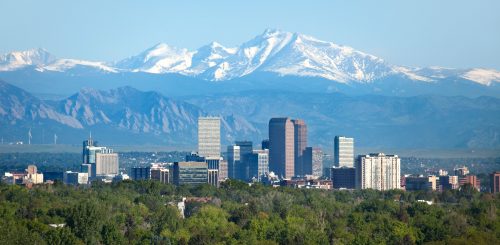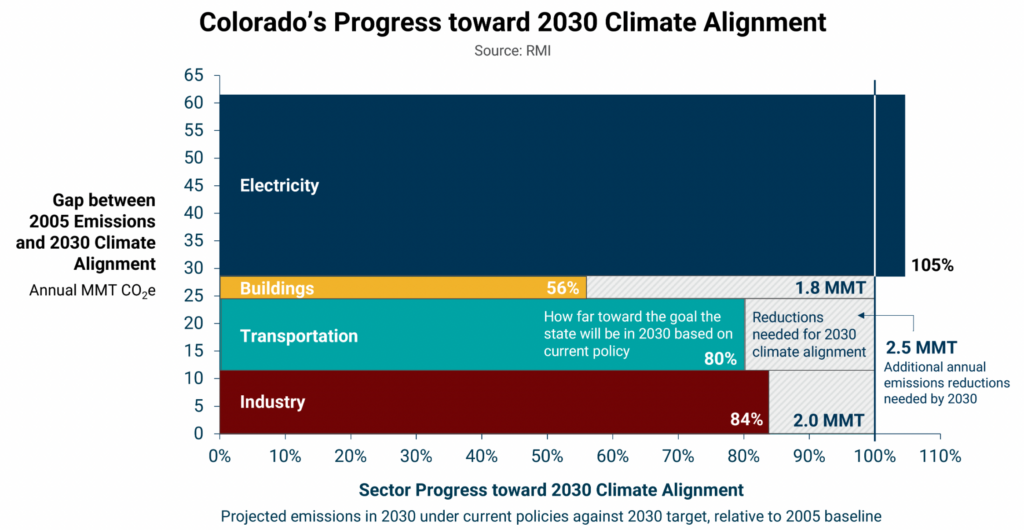
Building on Success: Colorado Makes Big Additional Investments in Climate. What’s Next?
Already a US leader, state lawmakers invested in electrifying school buses, cutting industrial emissions, electrifying buildings, and more. We round up the money-saving, climate-improving steps.
You don’t have to look past the front page of The New York Times to see the state of Colorado being recognized for its leadership on climate and clean energy. Colorado has made impressive progress in recent years in laying the groundwork for ambitious action to slash emissions from every sector of its economy — from transportation to buildings to electricity.
RMI’s State Climate Scorecards showed Colorado is one of six ambitious frontrunners racing to reach climate alignment, or cutting emissions roughly in half by 2030. Yet those scorecards, released in June, didn’t account for the impact of the state’s latest wave of new climate and clean energy policies that passed over the summer.
When we went back to analyze the impact of recent actions, it made a significant difference. With our latest updates to Colorado’s scorecard (and our Energy Policy Simulator that informs these scorecards), we show that the state is slated to reach 36% emissions reductions by 2030 (compared to 2005 levels). This means it’s consistently getting closer to its goal.
The sectors most impacted by the recent wins are:
- Electricity which, with recent state approval to accelerate closure of the Comanche 3 coal power plant to by the end of 2030, is now expected to exceed the electricity sector goal at 105 percent of the way to climate alignment, and
- Buildings which, due to the low-carbon building codes from HB22-1362, are now projected to be 56 percent of the way to climate alignment.
The bills signed in May and June make historic investments — more than $260 million — in policies and programs that will drive down emissions, reduce customer costs, and create new economic opportunities for Coloradans. They will also play a crucial role in tackling the Front Range’s worsening air quality problem, following the record-setting number of air quality alerts the state issued last year. And when coupled with the recent federal spending package — the largest and most ambitious clean energy investment in US history — Colorado and other states can leverage a full toolkit of strategies and funding sources to help secure a climate-resilient future.
These funding sources will also help pave the way for a more just and equitable transition. In recognition of the often-disproportionate impacts of historic energy systems on low-income communities and people of color, many bills require giving funding priority to projects and programs located in disproportionately impacted communities and/or areas with existing poor air quality.
Colorado’s Big Climate Wins
Some of the many investments coming out of the 2022 legislative session include:
- $65 million for a new school bus electrification grant program to help schools make the switch from diesel to electric buses, allowing Coloradans to benefit from improved air quality, quieter rides, and cost savings on fuel and maintenance, all while reducing climate-warming emissions. The funding makes Colorado the national leader in per capita investments in electric school buses. The state’s school districts can also look to leverage additional federal funding from the recent bipartisan infrastructure bill. Colorado’s program gives priority to schools located in disproportionately impacted communities, in areas with poor air quality, or in places that have high proportions of students receiving school meals for free or reduced cost (SB22-193).
- $25 million in grants to reduce air pollution from industrial and manufacturing operations, whether through efficiency improvements, electrifying equipment, or the use of emerging clean technologies such as green hydrogen or carbon capture. While more fully addressing industrial air pollution and GHG emissions will largely depend on the state’s development of robust emissions reduction standards, funding can play a key role — both in helping to finance capital-intensive projects and in reducing emissions beyond those required by regulation. Again, funding will prioritize air quality improvements in disproportionately impacted communities and/or areas with poor air quality (SB22-193).
- $20 million in grants for building electrification and highly efficient appliances in homes, businesses, and public buildings, with at least a third of funding reserved for low-income and disadvantaged communities. The bill also tackles building energy codes by raising minimum code requirements for localities and charting a course for the development and adoption of electric-ready, EV-ready, and low-carbon codes. Building code revisions present a significant opportunity to accelerate the transformation to all-electric, low-carbon buildings and ensure that the codes governing the state’s new buildings align with climate science (HB22-1362).
- $12 million in grants for geothermal energy to take advantage of the zero-carbon energy source for both electricity generation and building space heating and cooling (HB22-1381). The funding follows promising recent assessments of the resource’s uniquely high potential in the state. A complementary bill paves the way for the creation of shared “community geothermal gardens,” leveraging the successes of the community solar business model (SB22-118).
- $12 million to increase community access to electric bikes (e-bikes) through programs for local bikeshares and rebates for individual purchase. Priority is given to disproportionately impacted communities or those with poor air quality to allow these communities to benefit from the efficiency and air quality improvements offered by e-bikes. The program, which follows the wild success of Denver’s e-bike rebate program, is a win-win for reducing emissions from transportation — the largest single source of GHG pollution in the state (SB22-193).
- $7 million to support oil and gas aerial emissions monitoring, including increased state monitoring and investments in new state-of-the art monitoring technologies. These can help to more quickly find and fix methane and other leaks from oil and gas infrastructure and to develop more accurate inventories of industrial emissions. Acting now is critical: methane is over 80 times more potent than carbon dioxide when measured over a 20-year time frame (SB22-193).
Colorado also will invest $30 million to expand bus rapid transit, $28 million to cover free transit fares statewide during the ozone season, $20 million to support green rebuilding after disasters, and $3.5 million to increase the energy resilience of rural communities with microgrids.
This session’s action goes beyond investments, too, by giving state agencies new tools and mechanisms to reduce emissions. SB22-198, for example, created a new state enterprise to plug and clean up the state’s abandoned (or “orphaned) oil and gas drilling wells. The bill allows state agencies to tap into bonds and fees paid by the oil and gas industry — the amounts of which were significantly increased following sweeping reforms to the state’s Financial Assurance Rules in March 2022. These rules ensure that industry is paying its fair share to clean up current and future abandoned wells. Another bill directs agencies to develop a new program to regulate toxic and harmful air pollutants, including the adoption of health-based standards for certain toxics (HB22-1244).
Looking Ahead
To be clear, Colorado still has substantial work to do. Even after accounting for these latest developments, our analysis estimates that current policies would reduce the state’s total emissions only 36 percent by 2030 (relative to 2005 levels) — short of the 50 percent it has pledged.
Note: This analysis was conducted using the EPS for Colorado. Like our State Climate Scorecards, the 2030 targets for each sector are an average of multiple midcentury decarbonization studies (see methodology here for more detail). Our modeling does not account for policies that are not yet fully implemented. This may include legislation that has been passed but is subject to rulemaking processes for full implementation. This graphic also does not capture emissions from land use, agriculture, or waste, although reducing emissions from these sectors will play an important role in achieving climate alignment.
Meeting the state’s target to halve emissions by 2030 will require a dual focus on both effective implementation, verification, and enforcement of rules, as well as on new policies and programs to reduce emissions. For the first, state agencies still have work to do to bring the state’s 2021 GHG Pollution Reduction Roadmap to life. Strong rulemaking and associated verification are an often missed but crucial part of climate action. For example, verification rules under development by the Colorado Air Quality Control Commission will largely determine the success of a new state program to lower the emissions intensity of oil and gas production.
Crossing the 2030 finish line will also require new policies and programs to drive continued innovation and additional emissions reductions. In Colorado, this may include frameworks to support integrating newer technologies like clean hydrogen into industrial processes, rapid building electrification, and continued partnerships with local governments on inclusionary zoning reforms, which can help shift land use patterns to better align with climate goals. The state can look to leverage the clean energy investments and tax credits stemming from the Inflation Reduction Act as it charts its course forward.
While the state experiences firsthand the harmful and life-threatening effects of climate change and ozone pollution, its next steps are critical. The next steps of state agencies and regulators could help advance some of the most important climate policies in the country, delivering economic opportunity, improved environmental quality for residents, and a safer, more resilient future.
Technical Note:
As of today, we have updated our Energy Policy Simulator to incorporate the impacts of bills from the 2022 legislative session. Please see here for our technical documentation, including details about our modeling assumptions.
